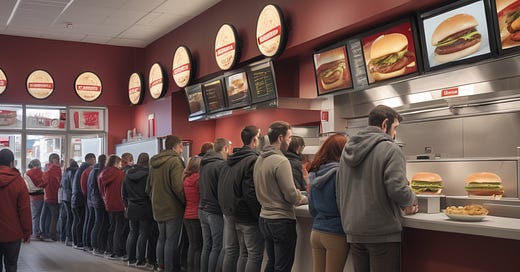The Precarious Nature of Surge Pricing
Industries with high demand fluctuations are introducing dynamic pricing.
Wendy's in the United State recently announced its intention to introduce a dynamic pricing model, which means that the prices of their menu items will fluctuate throughout the day demand surges and declines. This move is part of a $20 million investment in new digital menu boards that will enable Wendy's to adjust prices dynamically.
Dynamic pricing adjusts prices based on real-time factors like demand, time of day, and other variables. It allows businesses to optimise revenue by charging higher prices during peak hours and lower prices during off-peak times. Other industries, such as airlines and ride-sharing services like Uber, have already implemented dynamic pricing.
Some customers may find it convenient to pay a higher price for immediate service, while others may wait for a better deal. It allows retailers to better manage traffic throughout the day, leading to improved service for customers and it helps balance demand and supply, ensuring smoother operations.
The practice of dynamic pricing is more suited to certain industries as the success of Uber and Airbnb has shown. Industries with significant fluctuations in demand throughout the day, week, or year can benefit from adjusting prices to reflect those changes. Travel and hospitality, including airlines, hotels, and rental services experience peak seasons and off-peak times, making dynamic pricing a common practice. ride-sharing services like Uber and Lyft use surge pricing to incentivise drivers during high demand periods. Movie tickets, concert tickets, and sporting event tickets often see fluctuating prices based on demand and popularity.
Industries less suited for dynamic pricing include industries with consistent demand throughout the day or year may not benefit significantly from dynamic pricing. Customers might perceive frequent price changes as unnecessary or even unfair. For example, grocery stores, clothing stores, and other basic retail outlets usually maintain consistent pricing.
Customers are more accepting of dynamic pricing for products or services perceived as having variable value, such as live events or time-sensitive transportation, and implementing and managing dynamic pricing requires investment in technology and data analysis, so, might be less suitable for smaller businesses or those lacking the necessary resources. If competitors are not using dynamic pricing, adopting it might put a business at a disadvantage.
Wendy's experiment with dynamic pricing offers valuable insights for retailers, but carefully evaluating the potential benefits and challenges, as well as considering their specific market and customers, will be crucial for other businesses when deciding if and how to adopt this approach.
Before fully implementing a new pricing strategy, retailers should test it on a small scale to understand customer reactions and its effectiveness. Clear communication with customers about how and why prices change is essential for building trust and managing expectations is key. And it requires robust data analytics capabilities to understand customer behaviour and market trends.
The adoption of dynamic or surge pricing is not without its failures. Even those who have succeeded have experienced significant issues. During times of high demand, Uber's surge pricing has met significant customer backlash, with accusations of unfairness and exploitation. This negative perception has damaged brand loyalty and customer satisfaction.
Ticketmaster's dynamic pricing faced criticism for allegedly using deceptive practices and bots to inflate demand and raise ticket prices artificially, leading to public outrage and regulatory scrutiny, and Amazon's dynamic textbook pricing faced criticism for constantly fluctuating textbook prices based on student demand, making it difficult for them to budget and plan for their purchases. This inconsistency led to the company abandoning this practice.
Some airlines have faced difficulties implementing and managing dynamic pricing effectively, leading to confusion and frustration for customers due to unclear pricing structures and frequent fluctuations.
Other retailers who have implemented dynamic pricing across stores, has led to significant customer confusion and a drop in sales. These failures highlight the importance of considering the specific market and customer expectations before adopting such strategies.




